Dissertation on ASDA: Employee Turnover Cost Impact on Profit, 2022
VerifiedAdded on 2023/06/12
|67
|16026
|95
Thesis and Dissertation
AI Summary
This dissertation investigates the impact of employee turnover on ASDA's profitability in May 2022. It uses quantitative methods, including questionnaires and secondary data from books and articles, to determine the causes and costs associated with high employee turnover. The findings reveal that insufficient monetary benefits and a lack of appreciation contribute to employee dissatisfaction and turnover, leading to increased costs for the company. The study suggests strategies for employee retention and highlights the practical implications for ASDA and similar organizations. It concludes that addressing employee turnover is crucial for maintaining profitability and gaining a competitive advantage. The research contributes an original academic study on ASDA's employee turnover.
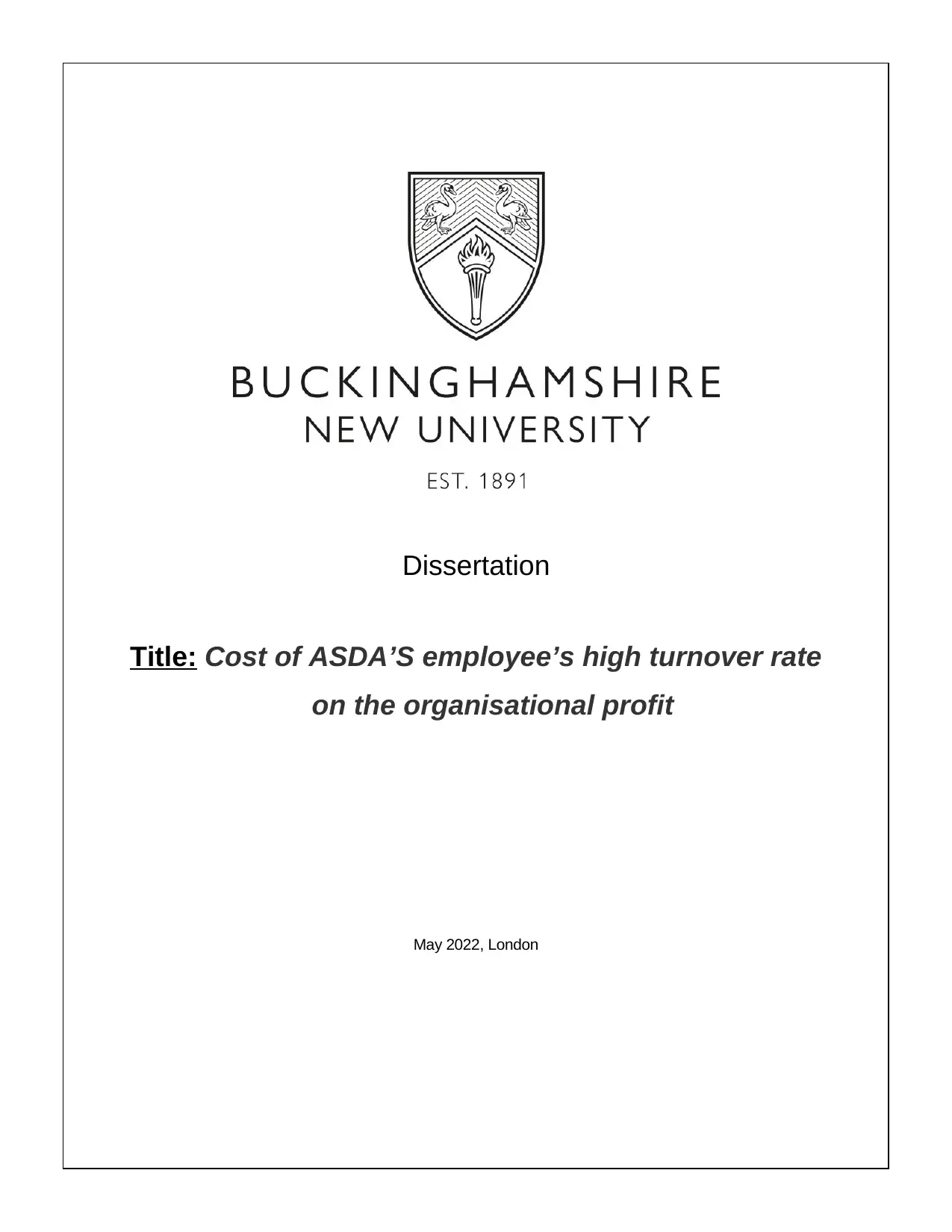
Dissertation
Title: Cost of ASDA’S employee’s high turnover rate
on the organisational profit
May 2022, London
Title: Cost of ASDA’S employee’s high turnover rate
on the organisational profit
May 2022, London
Paraphrase This Document
Need a fresh take? Get an instant paraphrase of this document with our AI Paraphraser
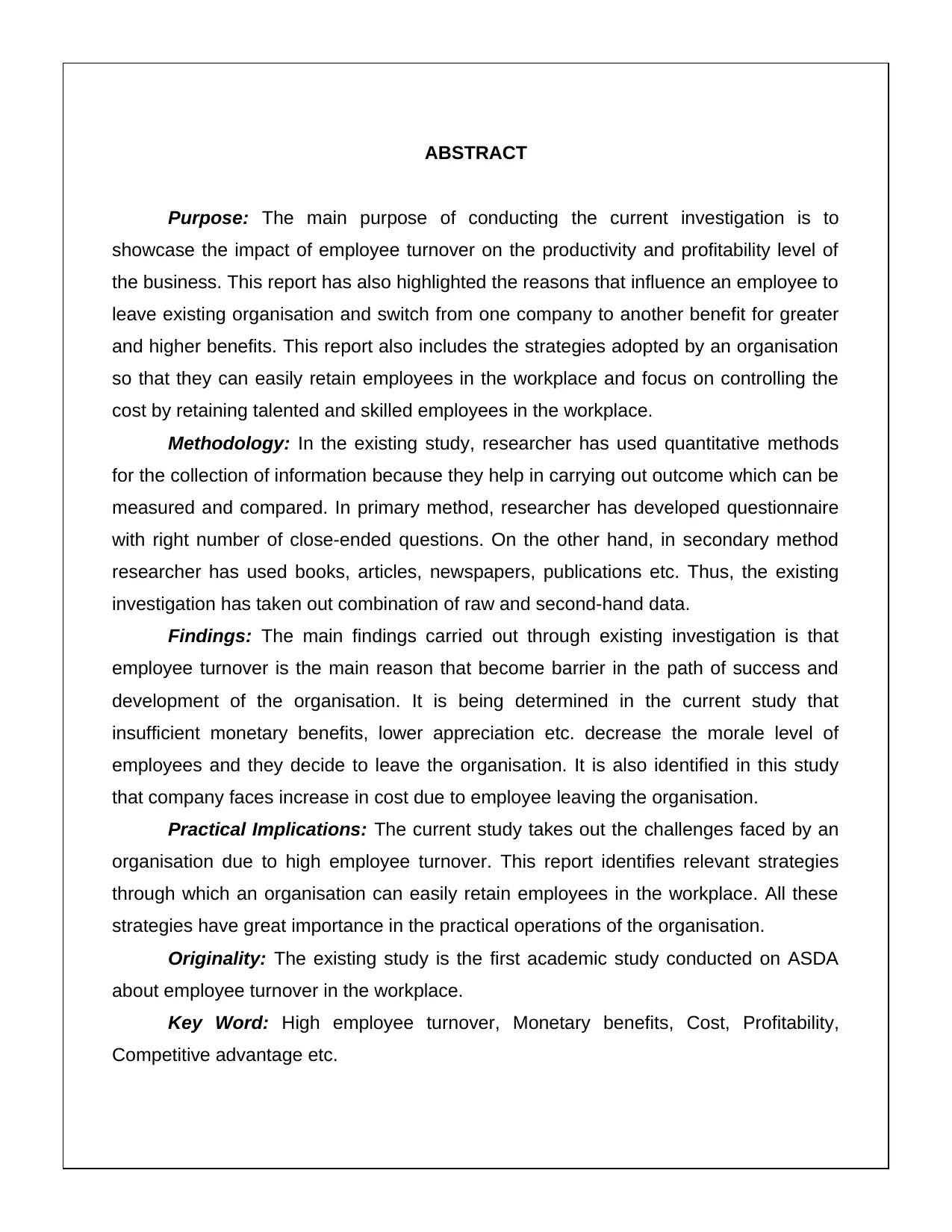
ABSTRACT
Purpose: The main purpose of conducting the current investigation is to
showcase the impact of employee turnover on the productivity and profitability level of
the business. This report has also highlighted the reasons that influence an employee to
leave existing organisation and switch from one company to another benefit for greater
and higher benefits. This report also includes the strategies adopted by an organisation
so that they can easily retain employees in the workplace and focus on controlling the
cost by retaining talented and skilled employees in the workplace.
Methodology: In the existing study, researcher has used quantitative methods
for the collection of information because they help in carrying out outcome which can be
measured and compared. In primary method, researcher has developed questionnaire
with right number of close-ended questions. On the other hand, in secondary method
researcher has used books, articles, newspapers, publications etc. Thus, the existing
investigation has taken out combination of raw and second-hand data.
Findings: The main findings carried out through existing investigation is that
employee turnover is the main reason that become barrier in the path of success and
development of the organisation. It is being determined in the current study that
insufficient monetary benefits, lower appreciation etc. decrease the morale level of
employees and they decide to leave the organisation. It is also identified in this study
that company faces increase in cost due to employee leaving the organisation.
Practical Implications: The current study takes out the challenges faced by an
organisation due to high employee turnover. This report identifies relevant strategies
through which an organisation can easily retain employees in the workplace. All these
strategies have great importance in the practical operations of the organisation.
Originality: The existing study is the first academic study conducted on ASDA
about employee turnover in the workplace.
Key Word: High employee turnover, Monetary benefits, Cost, Profitability,
Competitive advantage etc.
Purpose: The main purpose of conducting the current investigation is to
showcase the impact of employee turnover on the productivity and profitability level of
the business. This report has also highlighted the reasons that influence an employee to
leave existing organisation and switch from one company to another benefit for greater
and higher benefits. This report also includes the strategies adopted by an organisation
so that they can easily retain employees in the workplace and focus on controlling the
cost by retaining talented and skilled employees in the workplace.
Methodology: In the existing study, researcher has used quantitative methods
for the collection of information because they help in carrying out outcome which can be
measured and compared. In primary method, researcher has developed questionnaire
with right number of close-ended questions. On the other hand, in secondary method
researcher has used books, articles, newspapers, publications etc. Thus, the existing
investigation has taken out combination of raw and second-hand data.
Findings: The main findings carried out through existing investigation is that
employee turnover is the main reason that become barrier in the path of success and
development of the organisation. It is being determined in the current study that
insufficient monetary benefits, lower appreciation etc. decrease the morale level of
employees and they decide to leave the organisation. It is also identified in this study
that company faces increase in cost due to employee leaving the organisation.
Practical Implications: The current study takes out the challenges faced by an
organisation due to high employee turnover. This report identifies relevant strategies
through which an organisation can easily retain employees in the workplace. All these
strategies have great importance in the practical operations of the organisation.
Originality: The existing study is the first academic study conducted on ASDA
about employee turnover in the workplace.
Key Word: High employee turnover, Monetary benefits, Cost, Profitability,
Competitive advantage etc.
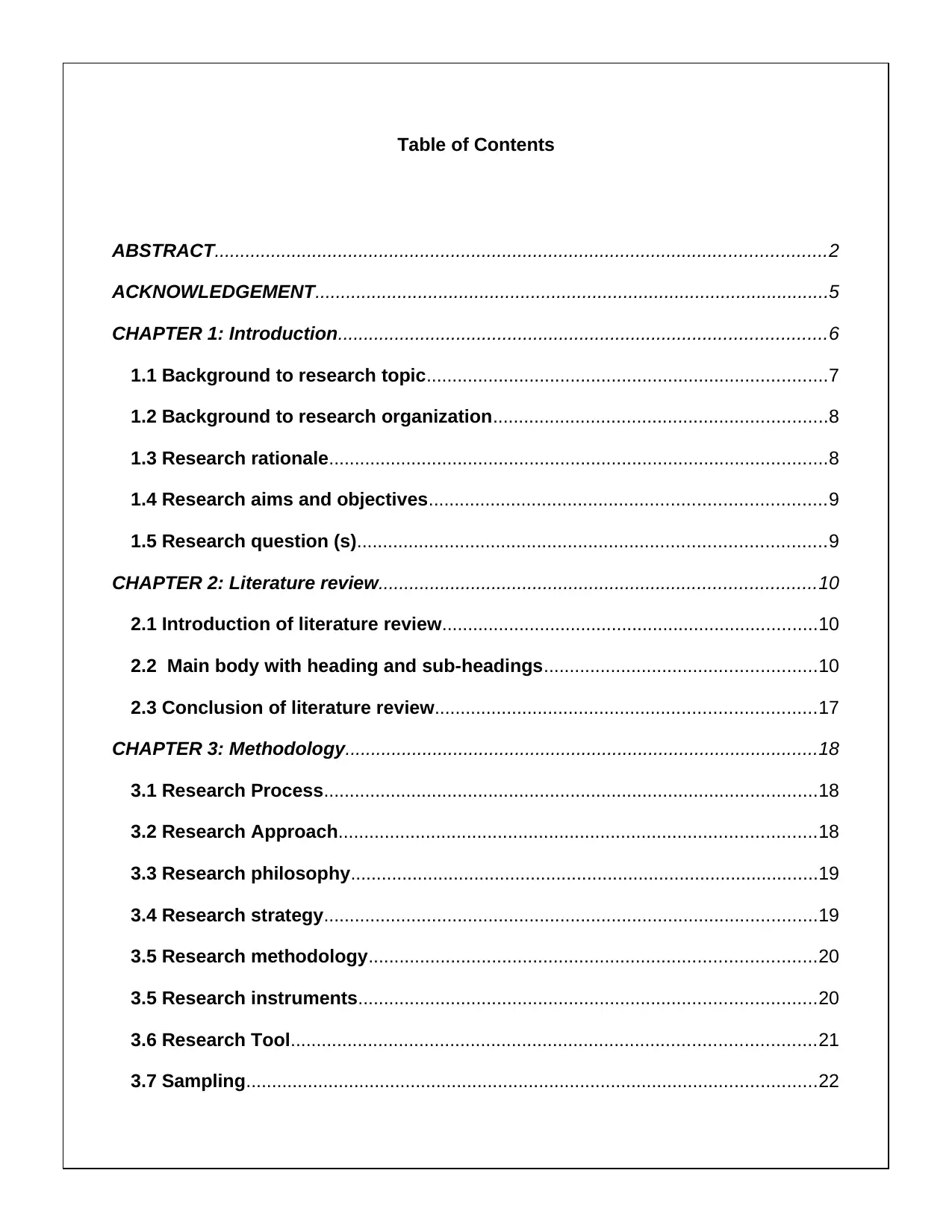
Table of Contents
ABSTRACT.......................................................................................................................2
ACKNOWLEDGEMENT....................................................................................................5
CHAPTER 1: Introduction...............................................................................................6
1.1 Background to research topic..............................................................................7
1.2 Background to research organization.................................................................8
1.3 Research rationale.................................................................................................8
1.4 Research aims and objectives.............................................................................9
1.5 Research question (s)...........................................................................................9
CHAPTER 2: Literature review.....................................................................................10
2.1 Introduction of literature review.........................................................................10
2.2 Main body with heading and sub-headings.....................................................10
2.3 Conclusion of literature review..........................................................................17
CHAPTER 3: Methodology............................................................................................18
3.1 Research Process................................................................................................18
3.2 Research Approach.............................................................................................18
3.3 Research philosophy...........................................................................................19
3.4 Research strategy................................................................................................19
3.5 Research methodology.......................................................................................20
3.5 Research instruments.........................................................................................20
3.6 Research Tool......................................................................................................21
3.7 Sampling...............................................................................................................22
ABSTRACT.......................................................................................................................2
ACKNOWLEDGEMENT....................................................................................................5
CHAPTER 1: Introduction...............................................................................................6
1.1 Background to research topic..............................................................................7
1.2 Background to research organization.................................................................8
1.3 Research rationale.................................................................................................8
1.4 Research aims and objectives.............................................................................9
1.5 Research question (s)...........................................................................................9
CHAPTER 2: Literature review.....................................................................................10
2.1 Introduction of literature review.........................................................................10
2.2 Main body with heading and sub-headings.....................................................10
2.3 Conclusion of literature review..........................................................................17
CHAPTER 3: Methodology............................................................................................18
3.1 Research Process................................................................................................18
3.2 Research Approach.............................................................................................18
3.3 Research philosophy...........................................................................................19
3.4 Research strategy................................................................................................19
3.5 Research methodology.......................................................................................20
3.5 Research instruments.........................................................................................20
3.6 Research Tool......................................................................................................21
3.7 Sampling...............................................................................................................22
⊘ This is a preview!⊘
Do you want full access?
Subscribe today to unlock all pages.

Trusted by 1+ million students worldwide
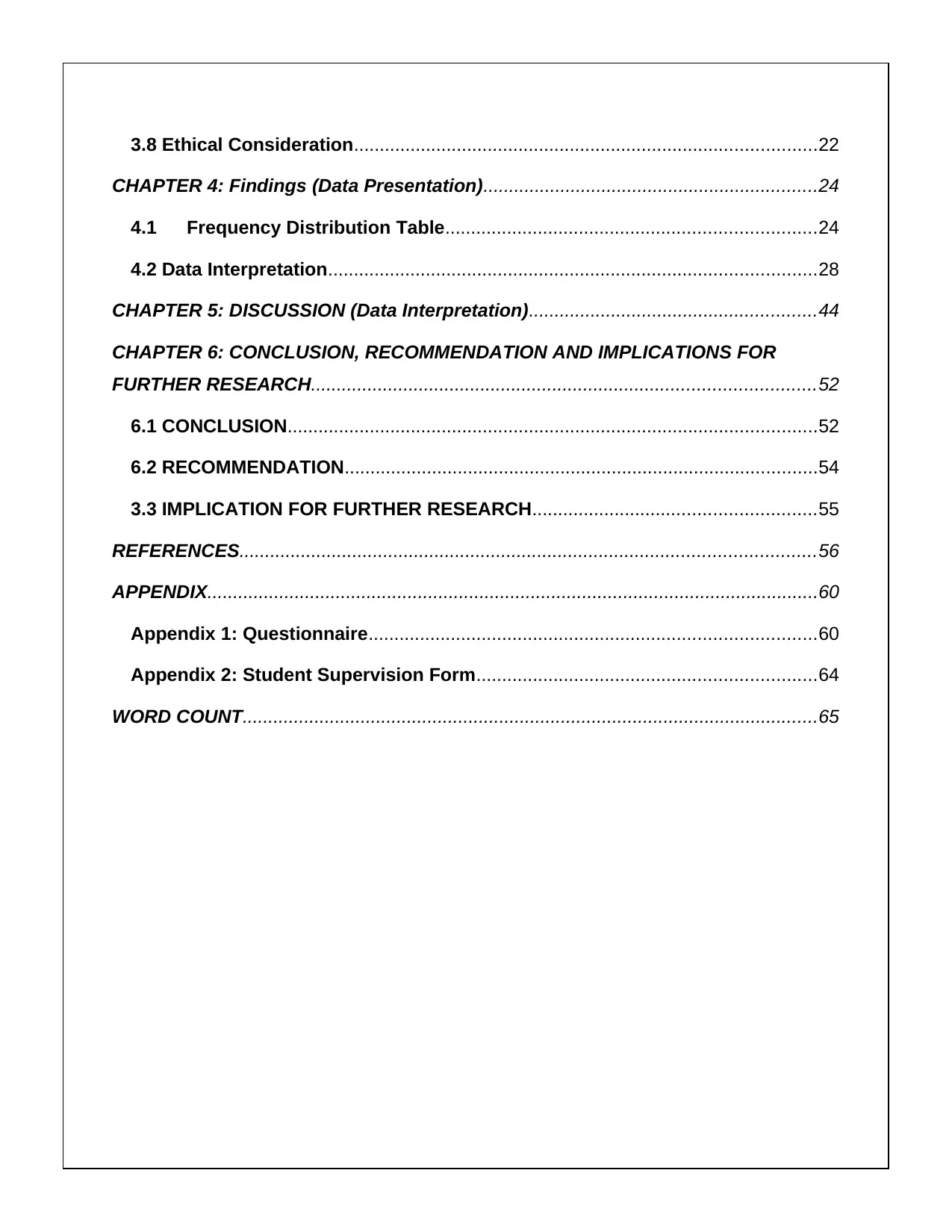
3.8 Ethical Consideration..........................................................................................22
CHAPTER 4: Findings (Data Presentation).................................................................24
4.1 Frequency Distribution Table........................................................................24
4.2 Data Interpretation...............................................................................................28
CHAPTER 5: DISCUSSION (Data Interpretation)........................................................44
CHAPTER 6: CONCLUSION, RECOMMENDATION AND IMPLICATIONS FOR
FURTHER RESEARCH..................................................................................................52
6.1 CONCLUSION.......................................................................................................52
6.2 RECOMMENDATION............................................................................................54
3.3 IMPLICATION FOR FURTHER RESEARCH.......................................................55
REFERENCES................................................................................................................56
APPENDIX.......................................................................................................................60
Appendix 1: Questionnaire.......................................................................................60
Appendix 2: Student Supervision Form..................................................................64
WORD COUNT................................................................................................................65
CHAPTER 4: Findings (Data Presentation).................................................................24
4.1 Frequency Distribution Table........................................................................24
4.2 Data Interpretation...............................................................................................28
CHAPTER 5: DISCUSSION (Data Interpretation)........................................................44
CHAPTER 6: CONCLUSION, RECOMMENDATION AND IMPLICATIONS FOR
FURTHER RESEARCH..................................................................................................52
6.1 CONCLUSION.......................................................................................................52
6.2 RECOMMENDATION............................................................................................54
3.3 IMPLICATION FOR FURTHER RESEARCH.......................................................55
REFERENCES................................................................................................................56
APPENDIX.......................................................................................................................60
Appendix 1: Questionnaire.......................................................................................60
Appendix 2: Student Supervision Form..................................................................64
WORD COUNT................................................................................................................65
Paraphrase This Document
Need a fresh take? Get an instant paraphrase of this document with our AI Paraphraser

ACKNOWLEDGEMENT
I am thankful to God who have made me capable enough to do something which
holds great importance in real life. I would like to thank my professor and supervisor
who have supported and shown confidence on me that I can do something worthwhile.
I am thankful to supervisor who has given their precious time to me so that they
can help me with determining the appropriate topic to conduct investigation in a
systematic way. They have helped me in forming research aim, objectives and
questions so that I can complete the whole investigation in the decided period of time.
Throughout my study, my professor has given valuable time by assisting me every time
whenever I needed them for reading out each copy of the draft, listened to me with
great patience, answered each query and assisted me in every stage of the research.
Thus, I am grateful to my professor and supervisor who have encouraged me to
improve my skill of thinking independently. I would like to thank my parents as well as
other family members who have supported me by helping me with different sources to
collect relevant and accurate piece of information. They have also supported me
whenever I felt frustrated and depressed with my pending work.
Last but not the least, I would like to thank each respondent selected from ASDA
as they have invested their precious time to help me with providing important
information.
I am thankful to God who have made me capable enough to do something which
holds great importance in real life. I would like to thank my professor and supervisor
who have supported and shown confidence on me that I can do something worthwhile.
I am thankful to supervisor who has given their precious time to me so that they
can help me with determining the appropriate topic to conduct investigation in a
systematic way. They have helped me in forming research aim, objectives and
questions so that I can complete the whole investigation in the decided period of time.
Throughout my study, my professor has given valuable time by assisting me every time
whenever I needed them for reading out each copy of the draft, listened to me with
great patience, answered each query and assisted me in every stage of the research.
Thus, I am grateful to my professor and supervisor who have encouraged me to
improve my skill of thinking independently. I would like to thank my parents as well as
other family members who have supported me by helping me with different sources to
collect relevant and accurate piece of information. They have also supported me
whenever I felt frustrated and depressed with my pending work.
Last but not the least, I would like to thank each respondent selected from ASDA
as they have invested their precious time to help me with providing important
information.
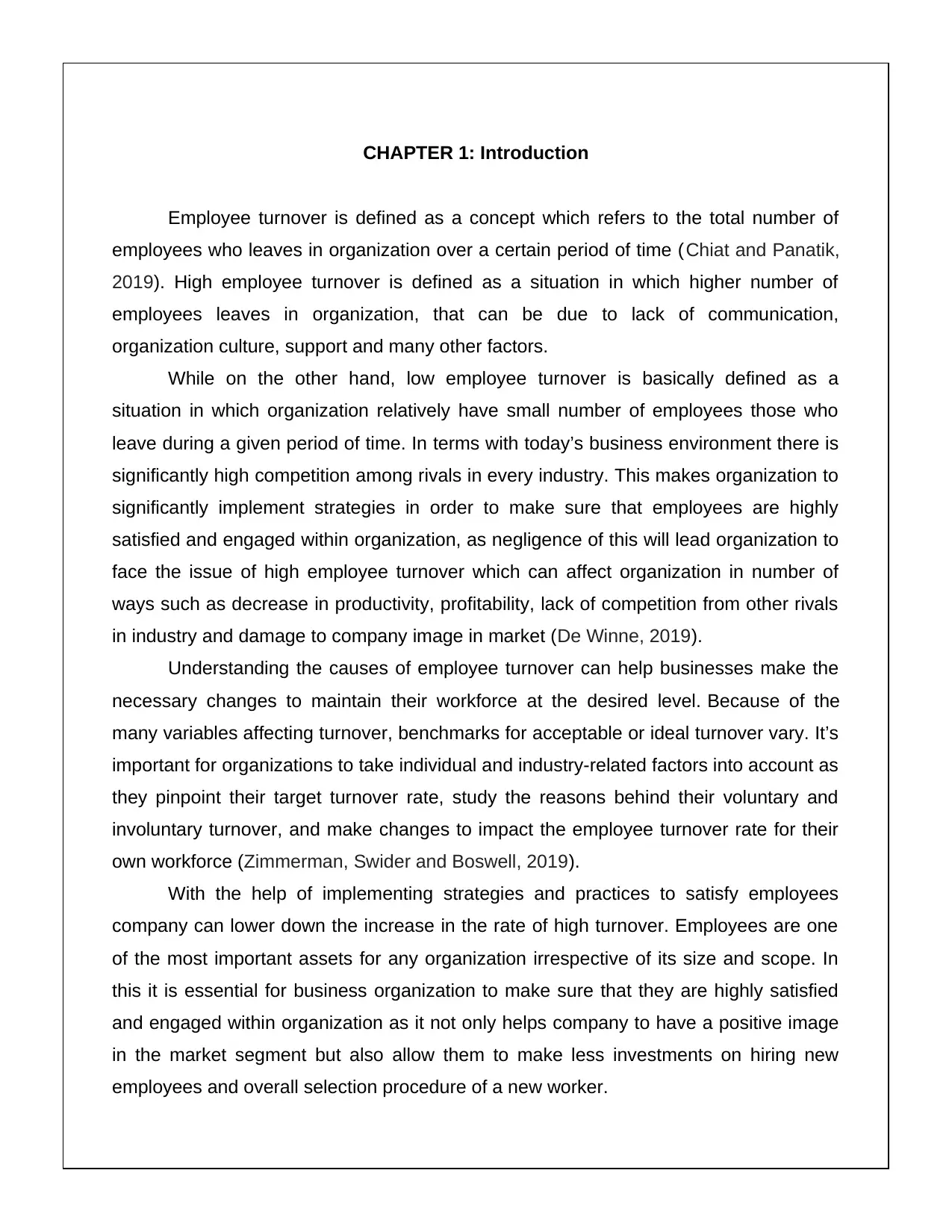
CHAPTER 1: Introduction
Employee turnover is defined as a concept which refers to the total number of
employees who leaves in organization over a certain period of time (Chiat and Panatik,
2019). High employee turnover is defined as a situation in which higher number of
employees leaves in organization, that can be due to lack of communication,
organization culture, support and many other factors.
While on the other hand, low employee turnover is basically defined as a
situation in which organization relatively have small number of employees those who
leave during a given period of time. In terms with today’s business environment there is
significantly high competition among rivals in every industry. This makes organization to
significantly implement strategies in order to make sure that employees are highly
satisfied and engaged within organization, as negligence of this will lead organization to
face the issue of high employee turnover which can affect organization in number of
ways such as decrease in productivity, profitability, lack of competition from other rivals
in industry and damage to company image in market (De Winne, 2019).
Understanding the causes of employee turnover can help businesses make the
necessary changes to maintain their workforce at the desired level. Because of the
many variables affecting turnover, benchmarks for acceptable or ideal turnover vary. It’s
important for organizations to take individual and industry-related factors into account as
they pinpoint their target turnover rate, study the reasons behind their voluntary and
involuntary turnover, and make changes to impact the employee turnover rate for their
own workforce (Zimmerman, Swider and Boswell, 2019).
With the help of implementing strategies and practices to satisfy employees
company can lower down the increase in the rate of high turnover. Employees are one
of the most important assets for any organization irrespective of its size and scope. In
this it is essential for business organization to make sure that they are highly satisfied
and engaged within organization as it not only helps company to have a positive image
in the market segment but also allow them to make less investments on hiring new
employees and overall selection procedure of a new worker.
Employee turnover is defined as a concept which refers to the total number of
employees who leaves in organization over a certain period of time (Chiat and Panatik,
2019). High employee turnover is defined as a situation in which higher number of
employees leaves in organization, that can be due to lack of communication,
organization culture, support and many other factors.
While on the other hand, low employee turnover is basically defined as a
situation in which organization relatively have small number of employees those who
leave during a given period of time. In terms with today’s business environment there is
significantly high competition among rivals in every industry. This makes organization to
significantly implement strategies in order to make sure that employees are highly
satisfied and engaged within organization, as negligence of this will lead organization to
face the issue of high employee turnover which can affect organization in number of
ways such as decrease in productivity, profitability, lack of competition from other rivals
in industry and damage to company image in market (De Winne, 2019).
Understanding the causes of employee turnover can help businesses make the
necessary changes to maintain their workforce at the desired level. Because of the
many variables affecting turnover, benchmarks for acceptable or ideal turnover vary. It’s
important for organizations to take individual and industry-related factors into account as
they pinpoint their target turnover rate, study the reasons behind their voluntary and
involuntary turnover, and make changes to impact the employee turnover rate for their
own workforce (Zimmerman, Swider and Boswell, 2019).
With the help of implementing strategies and practices to satisfy employees
company can lower down the increase in the rate of high turnover. Employees are one
of the most important assets for any organization irrespective of its size and scope. In
this it is essential for business organization to make sure that they are highly satisfied
and engaged within organization as it not only helps company to have a positive image
in the market segment but also allow them to make less investments on hiring new
employees and overall selection procedure of a new worker.
⊘ This is a preview!⊘
Do you want full access?
Subscribe today to unlock all pages.

Trusted by 1+ million students worldwide
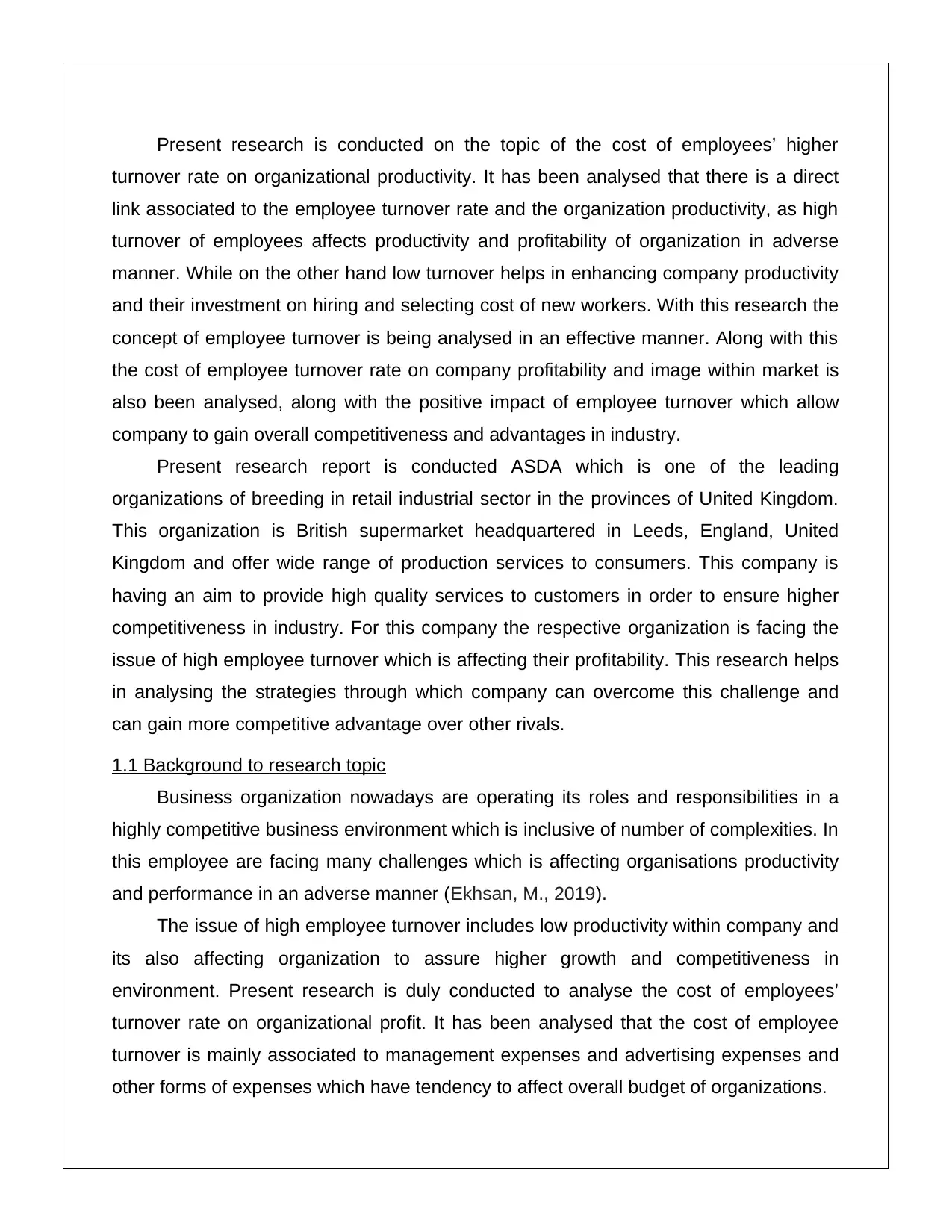
Present research is conducted on the topic of the cost of employees’ higher
turnover rate on organizational productivity. It has been analysed that there is a direct
link associated to the employee turnover rate and the organization productivity, as high
turnover of employees affects productivity and profitability of organization in adverse
manner. While on the other hand low turnover helps in enhancing company productivity
and their investment on hiring and selecting cost of new workers. With this research the
concept of employee turnover is being analysed in an effective manner. Along with this
the cost of employee turnover rate on company profitability and image within market is
also been analysed, along with the positive impact of employee turnover which allow
company to gain overall competitiveness and advantages in industry.
Present research report is conducted ASDA which is one of the leading
organizations of breeding in retail industrial sector in the provinces of United Kingdom.
This organization is British supermarket headquartered in Leeds, England, United
Kingdom and offer wide range of production services to consumers. This company is
having an aim to provide high quality services to customers in order to ensure higher
competitiveness in industry. For this company the respective organization is facing the
issue of high employee turnover which is affecting their profitability. This research helps
in analysing the strategies through which company can overcome this challenge and
can gain more competitive advantage over other rivals.
1.1 Background to research topic
Business organization nowadays are operating its roles and responsibilities in a
highly competitive business environment which is inclusive of number of complexities. In
this employee are facing many challenges which is affecting organisations productivity
and performance in an adverse manner (Ekhsan, M., 2019).
The issue of high employee turnover includes low productivity within company and
its also affecting organization to assure higher growth and competitiveness in
environment. Present research is duly conducted to analyse the cost of employees’
turnover rate on organizational profit. It has been analysed that the cost of employee
turnover is mainly associated to management expenses and advertising expenses and
other forms of expenses which have tendency to affect overall budget of organizations.
turnover rate on organizational productivity. It has been analysed that there is a direct
link associated to the employee turnover rate and the organization productivity, as high
turnover of employees affects productivity and profitability of organization in adverse
manner. While on the other hand low turnover helps in enhancing company productivity
and their investment on hiring and selecting cost of new workers. With this research the
concept of employee turnover is being analysed in an effective manner. Along with this
the cost of employee turnover rate on company profitability and image within market is
also been analysed, along with the positive impact of employee turnover which allow
company to gain overall competitiveness and advantages in industry.
Present research report is conducted ASDA which is one of the leading
organizations of breeding in retail industrial sector in the provinces of United Kingdom.
This organization is British supermarket headquartered in Leeds, England, United
Kingdom and offer wide range of production services to consumers. This company is
having an aim to provide high quality services to customers in order to ensure higher
competitiveness in industry. For this company the respective organization is facing the
issue of high employee turnover which is affecting their profitability. This research helps
in analysing the strategies through which company can overcome this challenge and
can gain more competitive advantage over other rivals.
1.1 Background to research topic
Business organization nowadays are operating its roles and responsibilities in a
highly competitive business environment which is inclusive of number of complexities. In
this employee are facing many challenges which is affecting organisations productivity
and performance in an adverse manner (Ekhsan, M., 2019).
The issue of high employee turnover includes low productivity within company and
its also affecting organization to assure higher growth and competitiveness in
environment. Present research is duly conducted to analyse the cost of employees’
turnover rate on organizational profit. It has been analysed that the cost of employee
turnover is mainly associated to management expenses and advertising expenses and
other forms of expenses which have tendency to affect overall budget of organizations.
Paraphrase This Document
Need a fresh take? Get an instant paraphrase of this document with our AI Paraphraser
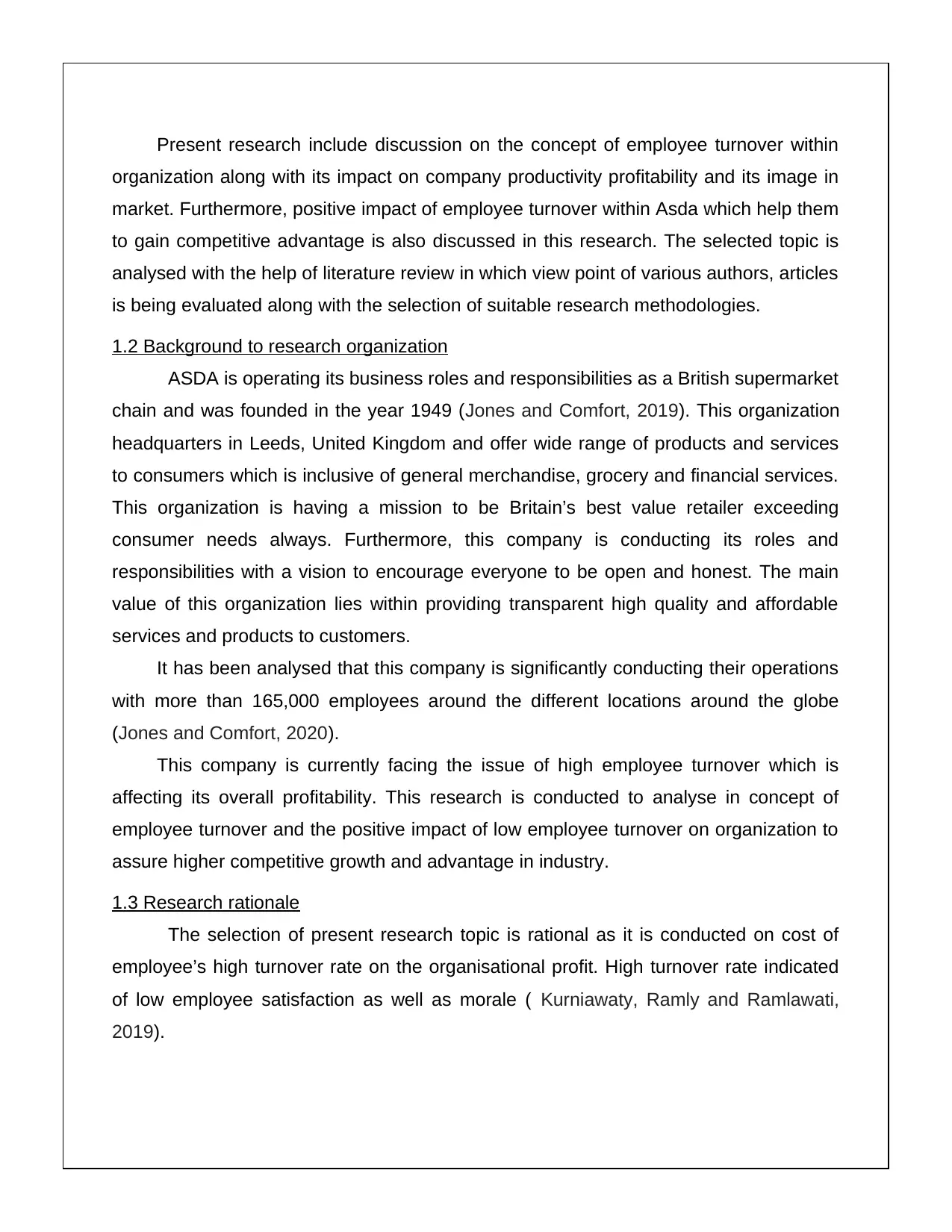
Present research include discussion on the concept of employee turnover within
organization along with its impact on company productivity profitability and its image in
market. Furthermore, positive impact of employee turnover within Asda which help them
to gain competitive advantage is also discussed in this research. The selected topic is
analysed with the help of literature review in which view point of various authors, articles
is being evaluated along with the selection of suitable research methodologies.
1.2 Background to research organization
ASDA is operating its business roles and responsibilities as a British supermarket
chain and was founded in the year 1949 (Jones and Comfort, 2019). This organization
headquarters in Leeds, United Kingdom and offer wide range of products and services
to consumers which is inclusive of general merchandise, grocery and financial services.
This organization is having a mission to be Britain’s best value retailer exceeding
consumer needs always. Furthermore, this company is conducting its roles and
responsibilities with a vision to encourage everyone to be open and honest. The main
value of this organization lies within providing transparent high quality and affordable
services and products to customers.
It has been analysed that this company is significantly conducting their operations
with more than 165,000 employees around the different locations around the globe
(Jones and Comfort, 2020).
This company is currently facing the issue of high employee turnover which is
affecting its overall profitability. This research is conducted to analyse in concept of
employee turnover and the positive impact of low employee turnover on organization to
assure higher competitive growth and advantage in industry.
1.3 Research rationale
The selection of present research topic is rational as it is conducted on cost of
employee’s high turnover rate on the organisational profit. High turnover rate indicated
of low employee satisfaction as well as morale ( Kurniawaty, Ramly and Ramlawati,
2019).
organization along with its impact on company productivity profitability and its image in
market. Furthermore, positive impact of employee turnover within Asda which help them
to gain competitive advantage is also discussed in this research. The selected topic is
analysed with the help of literature review in which view point of various authors, articles
is being evaluated along with the selection of suitable research methodologies.
1.2 Background to research organization
ASDA is operating its business roles and responsibilities as a British supermarket
chain and was founded in the year 1949 (Jones and Comfort, 2019). This organization
headquarters in Leeds, United Kingdom and offer wide range of products and services
to consumers which is inclusive of general merchandise, grocery and financial services.
This organization is having a mission to be Britain’s best value retailer exceeding
consumer needs always. Furthermore, this company is conducting its roles and
responsibilities with a vision to encourage everyone to be open and honest. The main
value of this organization lies within providing transparent high quality and affordable
services and products to customers.
It has been analysed that this company is significantly conducting their operations
with more than 165,000 employees around the different locations around the globe
(Jones and Comfort, 2020).
This company is currently facing the issue of high employee turnover which is
affecting its overall profitability. This research is conducted to analyse in concept of
employee turnover and the positive impact of low employee turnover on organization to
assure higher competitive growth and advantage in industry.
1.3 Research rationale
The selection of present research topic is rational as it is conducted on cost of
employee’s high turnover rate on the organisational profit. High turnover rate indicated
of low employee satisfaction as well as morale ( Kurniawaty, Ramly and Ramlawati,
2019).
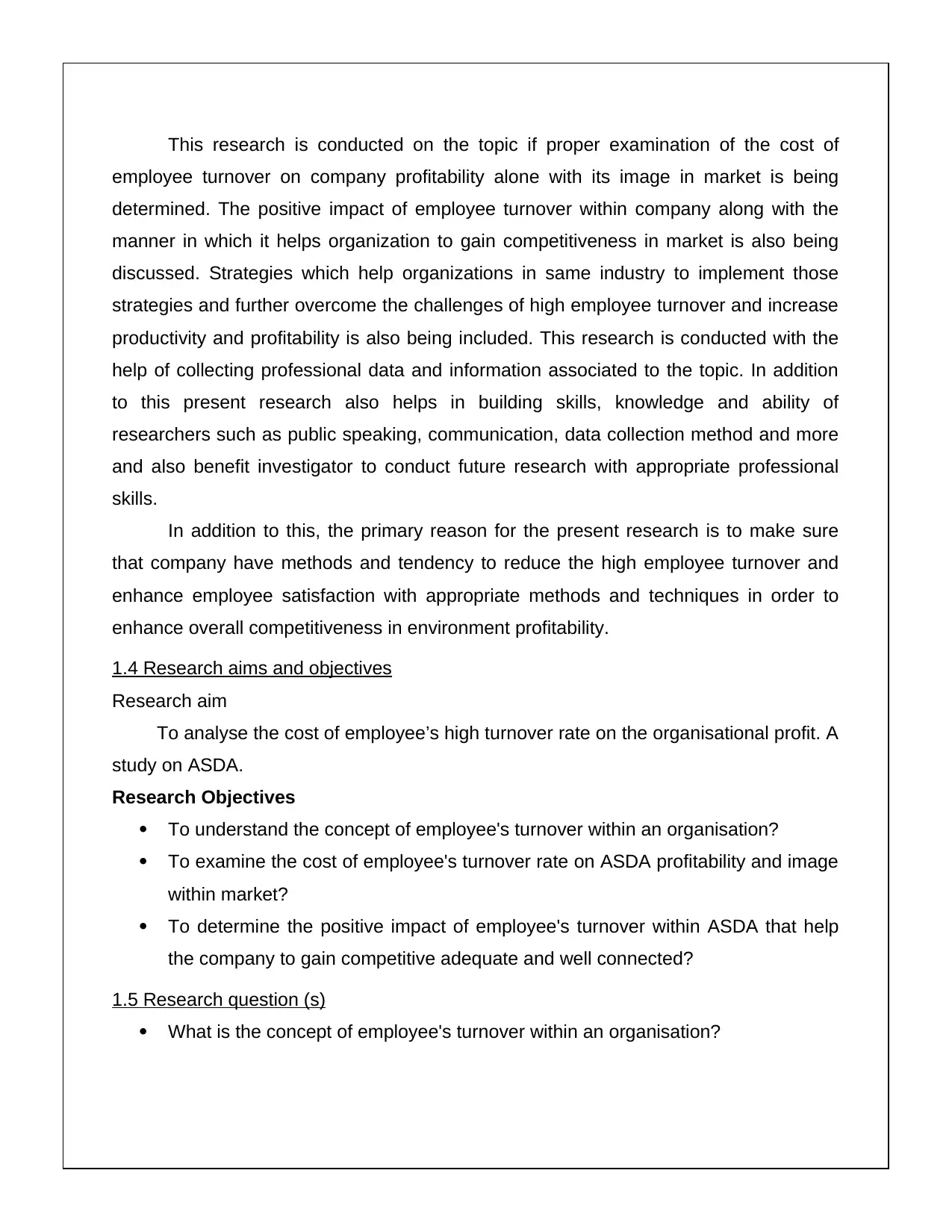
This research is conducted on the topic if proper examination of the cost of
employee turnover on company profitability alone with its image in market is being
determined. The positive impact of employee turnover within company along with the
manner in which it helps organization to gain competitiveness in market is also being
discussed. Strategies which help organizations in same industry to implement those
strategies and further overcome the challenges of high employee turnover and increase
productivity and profitability is also being included. This research is conducted with the
help of collecting professional data and information associated to the topic. In addition
to this present research also helps in building skills, knowledge and ability of
researchers such as public speaking, communication, data collection method and more
and also benefit investigator to conduct future research with appropriate professional
skills.
In addition to this, the primary reason for the present research is to make sure
that company have methods and tendency to reduce the high employee turnover and
enhance employee satisfaction with appropriate methods and techniques in order to
enhance overall competitiveness in environment profitability.
1.4 Research aims and objectives
Research aim
To analyse the cost of employee’s high turnover rate on the organisational profit. A
study on ASDA.
Research Objectives
To understand the concept of employee's turnover within an organisation?
To examine the cost of employee's turnover rate on ASDA profitability and image
within market?
To determine the positive impact of employee's turnover within ASDA that help
the company to gain competitive adequate and well connected?
1.5 Research question (s)
What is the concept of employee's turnover within an organisation?
employee turnover on company profitability alone with its image in market is being
determined. The positive impact of employee turnover within company along with the
manner in which it helps organization to gain competitiveness in market is also being
discussed. Strategies which help organizations in same industry to implement those
strategies and further overcome the challenges of high employee turnover and increase
productivity and profitability is also being included. This research is conducted with the
help of collecting professional data and information associated to the topic. In addition
to this present research also helps in building skills, knowledge and ability of
researchers such as public speaking, communication, data collection method and more
and also benefit investigator to conduct future research with appropriate professional
skills.
In addition to this, the primary reason for the present research is to make sure
that company have methods and tendency to reduce the high employee turnover and
enhance employee satisfaction with appropriate methods and techniques in order to
enhance overall competitiveness in environment profitability.
1.4 Research aims and objectives
Research aim
To analyse the cost of employee’s high turnover rate on the organisational profit. A
study on ASDA.
Research Objectives
To understand the concept of employee's turnover within an organisation?
To examine the cost of employee's turnover rate on ASDA profitability and image
within market?
To determine the positive impact of employee's turnover within ASDA that help
the company to gain competitive adequate and well connected?
1.5 Research question (s)
What is the concept of employee's turnover within an organisation?
⊘ This is a preview!⊘
Do you want full access?
Subscribe today to unlock all pages.

Trusted by 1+ million students worldwide
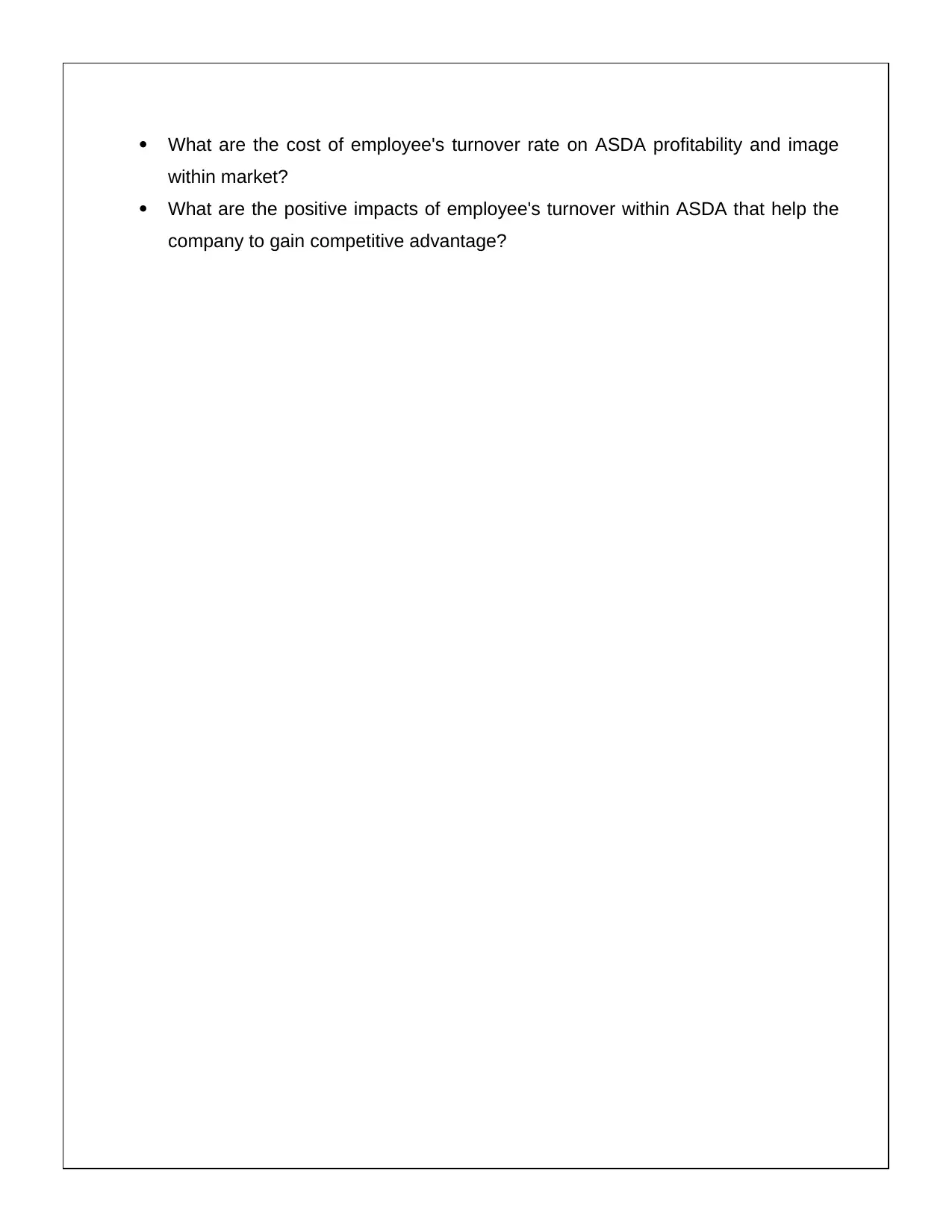
What are the cost of employee's turnover rate on ASDA profitability and image
within market?
What are the positive impacts of employee's turnover within ASDA that help the
company to gain competitive advantage?
within market?
What are the positive impacts of employee's turnover within ASDA that help the
company to gain competitive advantage?
Paraphrase This Document
Need a fresh take? Get an instant paraphrase of this document with our AI Paraphraser
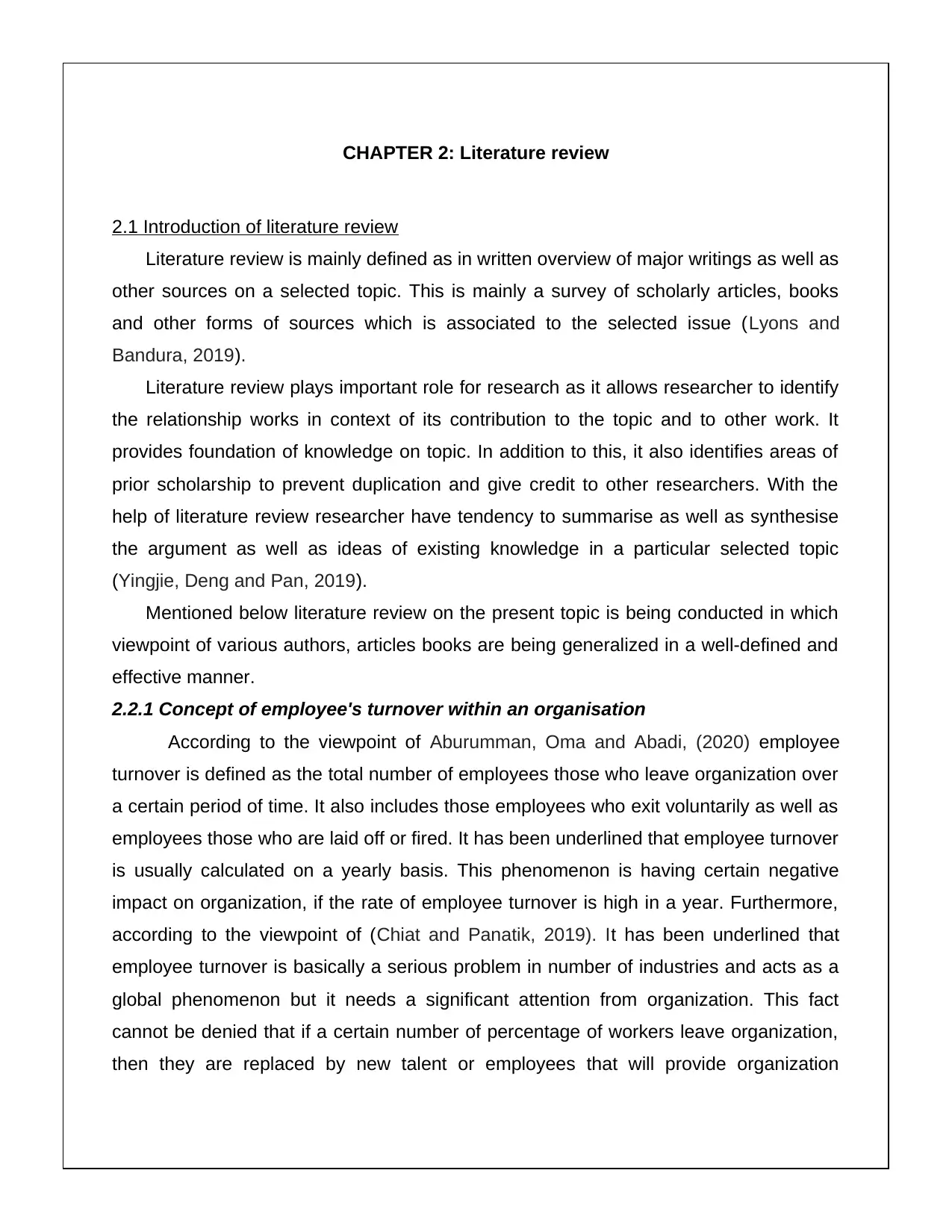
CHAPTER 2: Literature review
2.1 Introduction of literature review
Literature review is mainly defined as in written overview of major writings as well as
other sources on a selected topic. This is mainly a survey of scholarly articles, books
and other forms of sources which is associated to the selected issue (Lyons and
Bandura, 2019).
Literature review plays important role for research as it allows researcher to identify
the relationship works in context of its contribution to the topic and to other work. It
provides foundation of knowledge on topic. In addition to this, it also identifies areas of
prior scholarship to prevent duplication and give credit to other researchers. With the
help of literature review researcher have tendency to summarise as well as synthesise
the argument as well as ideas of existing knowledge in a particular selected topic
(Yingjie, Deng and Pan, 2019).
Mentioned below literature review on the present topic is being conducted in which
viewpoint of various authors, articles books are being generalized in a well-defined and
effective manner.
2.2.1 Concept of employee's turnover within an organisation
According to the viewpoint of Aburumman, Oma and Abadi, (2020) employee
turnover is defined as the total number of employees those who leave organization over
a certain period of time. It also includes those employees who exit voluntarily as well as
employees those who are laid off or fired. It has been underlined that employee turnover
is usually calculated on a yearly basis. This phenomenon is having certain negative
impact on organization, if the rate of employee turnover is high in a year. Furthermore,
according to the viewpoint of (Chiat and Panatik, 2019). It has been underlined that
employee turnover is basically a serious problem in number of industries and acts as a
global phenomenon but it needs a significant attention from organization. This fact
cannot be denied that if a certain number of percentage of workers leave organization,
then they are replaced by new talent or employees that will provide organization
2.1 Introduction of literature review
Literature review is mainly defined as in written overview of major writings as well as
other sources on a selected topic. This is mainly a survey of scholarly articles, books
and other forms of sources which is associated to the selected issue (Lyons and
Bandura, 2019).
Literature review plays important role for research as it allows researcher to identify
the relationship works in context of its contribution to the topic and to other work. It
provides foundation of knowledge on topic. In addition to this, it also identifies areas of
prior scholarship to prevent duplication and give credit to other researchers. With the
help of literature review researcher have tendency to summarise as well as synthesise
the argument as well as ideas of existing knowledge in a particular selected topic
(Yingjie, Deng and Pan, 2019).
Mentioned below literature review on the present topic is being conducted in which
viewpoint of various authors, articles books are being generalized in a well-defined and
effective manner.
2.2.1 Concept of employee's turnover within an organisation
According to the viewpoint of Aburumman, Oma and Abadi, (2020) employee
turnover is defined as the total number of employees those who leave organization over
a certain period of time. It also includes those employees who exit voluntarily as well as
employees those who are laid off or fired. It has been underlined that employee turnover
is usually calculated on a yearly basis. This phenomenon is having certain negative
impact on organization, if the rate of employee turnover is high in a year. Furthermore,
according to the viewpoint of (Chiat and Panatik, 2019). It has been underlined that
employee turnover is basically a serious problem in number of industries and acts as a
global phenomenon but it needs a significant attention from organization. This fact
cannot be denied that if a certain number of percentage of workers leave organization,
then they are replaced by new talent or employees that will provide organization
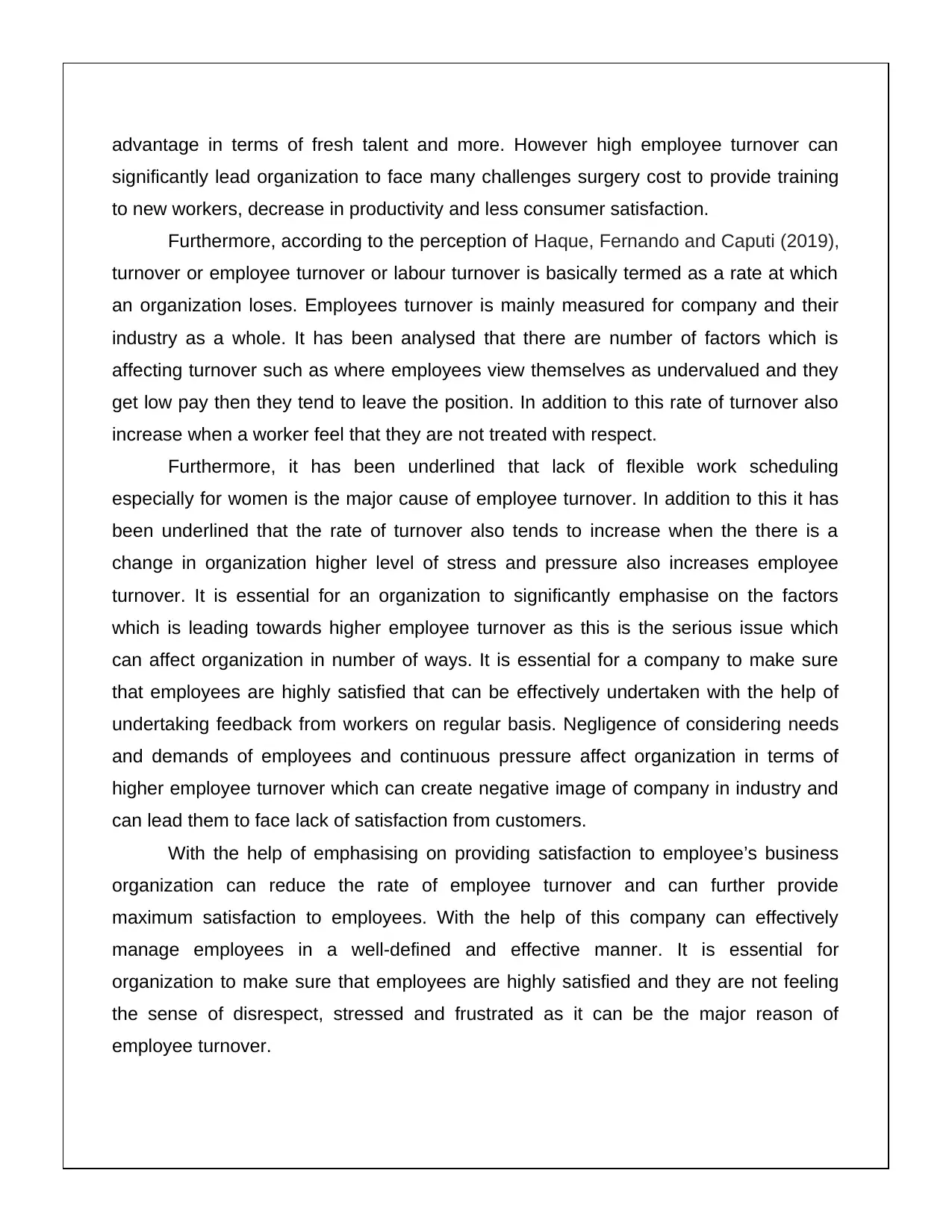
advantage in terms of fresh talent and more. However high employee turnover can
significantly lead organization to face many challenges surgery cost to provide training
to new workers, decrease in productivity and less consumer satisfaction.
Furthermore, according to the perception of Haque, Fernando and Caputi (2019),
turnover or employee turnover or labour turnover is basically termed as a rate at which
an organization loses. Employees turnover is mainly measured for company and their
industry as a whole. It has been analysed that there are number of factors which is
affecting turnover such as where employees view themselves as undervalued and they
get low pay then they tend to leave the position. In addition to this rate of turnover also
increase when a worker feel that they are not treated with respect.
Furthermore, it has been underlined that lack of flexible work scheduling
especially for women is the major cause of employee turnover. In addition to this it has
been underlined that the rate of turnover also tends to increase when the there is a
change in organization higher level of stress and pressure also increases employee
turnover. It is essential for an organization to significantly emphasise on the factors
which is leading towards higher employee turnover as this is the serious issue which
can affect organization in number of ways. It is essential for a company to make sure
that employees are highly satisfied that can be effectively undertaken with the help of
undertaking feedback from workers on regular basis. Negligence of considering needs
and demands of employees and continuous pressure affect organization in terms of
higher employee turnover which can create negative image of company in industry and
can lead them to face lack of satisfaction from customers.
With the help of emphasising on providing satisfaction to employee’s business
organization can reduce the rate of employee turnover and can further provide
maximum satisfaction to employees. With the help of this company can effectively
manage employees in a well-defined and effective manner. It is essential for
organization to make sure that employees are highly satisfied and they are not feeling
the sense of disrespect, stressed and frustrated as it can be the major reason of
employee turnover.
significantly lead organization to face many challenges surgery cost to provide training
to new workers, decrease in productivity and less consumer satisfaction.
Furthermore, according to the perception of Haque, Fernando and Caputi (2019),
turnover or employee turnover or labour turnover is basically termed as a rate at which
an organization loses. Employees turnover is mainly measured for company and their
industry as a whole. It has been analysed that there are number of factors which is
affecting turnover such as where employees view themselves as undervalued and they
get low pay then they tend to leave the position. In addition to this rate of turnover also
increase when a worker feel that they are not treated with respect.
Furthermore, it has been underlined that lack of flexible work scheduling
especially for women is the major cause of employee turnover. In addition to this it has
been underlined that the rate of turnover also tends to increase when the there is a
change in organization higher level of stress and pressure also increases employee
turnover. It is essential for an organization to significantly emphasise on the factors
which is leading towards higher employee turnover as this is the serious issue which
can affect organization in number of ways. It is essential for a company to make sure
that employees are highly satisfied that can be effectively undertaken with the help of
undertaking feedback from workers on regular basis. Negligence of considering needs
and demands of employees and continuous pressure affect organization in terms of
higher employee turnover which can create negative image of company in industry and
can lead them to face lack of satisfaction from customers.
With the help of emphasising on providing satisfaction to employee’s business
organization can reduce the rate of employee turnover and can further provide
maximum satisfaction to employees. With the help of this company can effectively
manage employees in a well-defined and effective manner. It is essential for
organization to make sure that employees are highly satisfied and they are not feeling
the sense of disrespect, stressed and frustrated as it can be the major reason of
employee turnover.
⊘ This is a preview!⊘
Do you want full access?
Subscribe today to unlock all pages.

Trusted by 1+ million students worldwide
1 out of 67
Related Documents
Your All-in-One AI-Powered Toolkit for Academic Success.
+13062052269
info@desklib.com
Available 24*7 on WhatsApp / Email
![[object Object]](/_next/static/media/star-bottom.7253800d.svg)
Unlock your academic potential
Copyright © 2020–2025 A2Z Services. All Rights Reserved. Developed and managed by ZUCOL.





